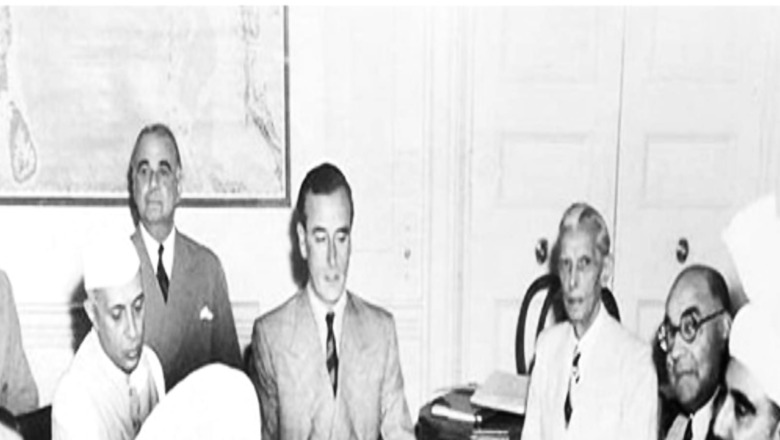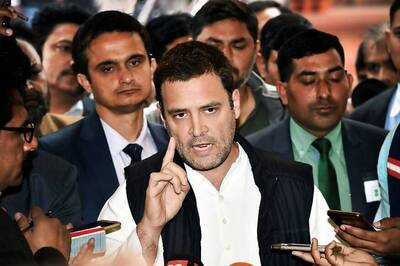
views
The elections of 1946 in undivided India changed the course of civilisation forever. The elections were contested primarily between the then-Indian National Congress (Congress) and the now-defunct All India Muslim League (Muslim League). There were other smaller regional parties, but the election was essentially a referendum on the political stance of the two largest parties in undivided India. The results clearly showed the communal fissures in the fabric of India, which were in making for a long time.
The Congress fought the elections as a party representing the interests of all sections of society, including that of the Muslims. The Muslim League, on the other hand, put the Muslim interest as its only ploy to get Muslim votes. The results of the election made the Congress the largest party with 923 seats (58 percent) out of the total 1585 seats in the provincial legislature. The Muslim League won 425 seats (26.8 percent) and a staggering 87 percent of the reserved Muslim seats. In the larger scheme of things, the Muslim League lost the elections, but did it?
The electoral process of 1946 was very different from what we see today. To understand the results of those elections, we have to go back to 1905, when India witnessed a prequel to the events of 1947, leading to the partition of the country. The British Crown colony of India was then administered in two separate sections. One was the section which was under the direct control of the Crown and was divided into provinces. The second section was that of the princely states, which were under the indirect control of the Crown.
The Build Up
In 1905, Lord Curzon, the then Viceroy of India, took an administrative step and partitioned Bengal–the most populous province of India–into Eastern and Western blocs. The step was apparently taken for the smooth administration of the province, which otherwise had become too large to manage. The new border of divided Bengal ran roughly along the modern-day international border between the Indian state of West Bengal and Bangladesh. The resulting provinces of western Bengal also included the modern-day states of Bihar, Jharkhand and parts of Odisha and Chhattisgarh. The eastern Bengal province included the former colonial province of Assam (including much of modern Northeastern India).
The partition of Bengal by the Crown led to large-scale demonstrations by the people. There were two prime reasons for the opposition. The first was the demographic change in both provinces. The western Bengal province now had non-Bengalis from Bihar, Jharkhand, Odisha and Chhattisgarh, which made the Bengalis a linguistic minority in the province. The eastern province, on the other hand, was now predominantly Muslim. The second reason was that people saw the division as an attempt to divide the Bengalis on communal lines.
In the aftermath of the division, a large-scale popular Swadeshi movement began in Bengal, to reverse the partition. However, the opposition to partition of Bengal was not universal. While the Congress opposed the partition and the sentiments were supported by the common masses in western Bengal, the partition was welcomed by the eastern province, which was predominantly Muslim.
The fourth Nawab of Dhaka, Khwaja Salimullah, who was also serving the government was a staunch supporter of the partition. The Nawab’s support for partition is well documented. The 2011 book by Nitish Sengupta, Land of Two Rivers: A History of Bengal and Vinod Kumar Saxena’s The Partition of Bengal (1905 – 1911), 1978 talks in detail about how the Nawab supported the partition.
In the following year in 1906, Salimullah formed the Muslim League at a gathering of Muslim leaders from across the country. The gathering was convened at his official residence and at his own cost.
Setting The Stage
The popular protests against the partition of Bengal became violent and eventually, the British government reversed the decision in 1911. In the intervening years, a major political change happened. The Indian Councils Act of 1909 was passed by the British Parliament. More commonly known as the Morley Minto Reforms, the Act was supposed to decentralise the administration and give Indians more say in governance. However, the Act also provided for a separate electorate for Hindus and Muslims.
The concept of a separate electorate was put forward at the behest of the Muslim League, which was of the view that Muslims can only be represented properly in the government if there is a separate electorate for them. According to the provisions of separate electorate, Hindus and Muslims were to be divided into two separate constituencies. The new system meant that only a Muslim would contest the seats deemed to be Muslim majority. Any party that wants to contest the seats will have to appoint a Muslim candidate. Similarly, a deemed Hindu constituency will only have a Hindu as a contestant.
The total population of India, according to the Census of 1941, was around 386.6 million, of which Hindus were around 256.9 million and Muslims around 92 million. The composition of Hindus in the population stood at 66.4 percent and Muslims at 24 percent. The delimitation process of the reserved seats for Muslims returned a total of 492 seats, i.e. 31 percent of the total 1585 seats. This was more than what the Muslim League argued for. The Muslim League now had a disproportionate advantage of over-representation. An over-representation should have ideally addressed the Muslim League’s demand of safeguarding Muslim interests in a Hindu dominated India. But the party had a different agenda.
The provision of a separate electorate proved to be a crucial factor in the elections of 1946. In the previous elections, Indians were given limited access to the electoral process. Only the landed and high tax-paying citizens could vote. Those elections were essentially an exercise by and for the elites of the society. Further changes were made in the electoral process by the Government of India Act, 1919 and 1935.
The Government of India Act, 1935, significantly increased the number of eligible voters. Women too were allowed to vote, however, their rights to vote were linked to the rights of their husbands. Despite the relaxations in the eligibility, only a small section, approximately 20 percent of the adult population qualified as voters.
The Simmering
The elections of 1937 were held according to the Government of India Act 1935, with a larger electorate. However, the elections were swept by the Congress. Muslim League managed to perform well in the provinces of Assam, Bengal, Bombay, the United Province (UP) and Madras, but failed to get a majority in any of the provinces. The provinces of Bengal and UP elected the maximum number of Muslim League members. The most shocking results came from Punjab where the League managed to win only one seat. The Unionist Party, with a large support base among the landed elites, won 95 of the total 175 seats in the province. Congress managed to win only 18 seats.
The years preceding the elections of 1937 have witnessed the demand for a separate Muslim nation-state by the Muslim League. Iqbal, during the Allahabad session (1930) of the Muslim League, put forth his vision of a separate Muslim state, comprising the provinces in northwest India (roughly the modern State of Pakistan).
Iqbal of 1908 was, however, very different from Iqbal of 1904. Having written Tarana-i-Hindi (Sare Jahan se Achha) in 1904 before going to Europe, he wrote Tarana-i-Milli upon his return. The change from a yearning of a united India to a near-lunatic dream of a global Islamic state, Iqbal emerged as the most powerful figure to support the Two Nation theory.
Iqbal’s Two Nation theory, in 1930, was a vague concept, which wanted an Islamic State within British India. His argument was based purely on communal lines, where he believed that the Muslims, with their distinct religious and cultural identities, cannot coexist with the majority of Hindus. He was also opposed to the then Congress’ view of a secular nation, which will look after all its citizens. The Iqbal of Tarana-i-Hindi was now talking exclusively of the Muslim ‘interest’.
Iqbal may have, in his own mind, made a very strong case for an Islamic State within British India, however, it failed to appeal to the Muslim masses. The results of the 1937 elections proved that the Muslim League’s idea of a separate Islamic State was still simmering. Post-elections, the Congress did not form a coalition government with the Muslim League and almost all non-Congress Muslim representatives were in Opposition. This acted as a trigger for anti-Congress consolidation among the Muslims who thought they would never be able to govern till the Congress enjoyed popular Hindu support.
The Last Mile
So how did the Muslim League, a near failure in 1937, turned into the fountainhead of partition? Between the years 1937 and 1946, when the next elections were held, the Muslim League stepped up its membership drive and metamorphosed from an elite organisation into a mass movement among Indian Muslims. A fresh convert from the Congress to the League, Jinnah started using Iqbal’s rhetoric of Islamic unity and concepts of a separate Islamic State in his speeches. The campaign for the 1946 elections was painted in extreme Islamic colours where voting for the Muslim League was made a mandatory Islamic act.
The elections of 1946 were fought by the Muslim League on very clear terms. The ultimate objective of the League was the creation of a separate Islamic State, carved out of India. To seek popular support from Muslims, the League roped in the Muslim community leaders, who would then propagate the League propaganda to the last mile. Jinnah’s status was elevated to that of a demigod. In the 1946 Sunni Conference at Varanasi, Pir Jamat Ali Shah, a Sunni Barelvi leader, declared that Jinnah was a custodian of God or a Waliullah (Empire and Islam: Punjab and the making of Pakistan, David Gilmartin, 1988). Ali Shah also issued fatwas declaring any Muslim voting against the idea of Pakistan as an infidel. The fatwa said, no Namaz-e-Janaza would be offered to such people and they would not be buried in Muslim graveyards.
Devendra Panigrahi’s, ‘India’s partition: The story of imperialism in retreat’ mentions how the Pirs, revered by both Hindus and Muslims, were roped in by the Muslim League to propagate the cause of Pakistan. Influential Pirs like the Pir of Manki Sharif, Jamaat Ali Shah, Khwaza Nizamuddin of Taunsa and Mukhdun Raji Shah of Multan were coopted by the Muslim League to rally the cause of Pakistan. The Pirs conferred the titles of Pir and Sajjada Nashin (caretaker/successor of a Pir) on members of the Muslim League. Prominent members like Shaukat Hayat Khan, Feroz Khan Noon and Iftikhar Hussain Mamdot were given semi-divine status by the Pirs to make them popular among the Muslims.
Students from Islamic seminaries were used to spread the message of Pakistan. Mosques and Friday sermons were used for urging the Muslims to vote for the Muslim League. The overtly dangerous and Islamist approach of the Muslim League in the run-up to the elections was also shared by the then-Governor of Punjab, Bertrand Glancy. On August 16, 1945, he sent his fortnightly report to the Governor General of India, Archibald Wavell.
The report mentioned –“Here is a very serious danger of the elections being fought, so far as Muslims are concerned, on an entirely false issue. Crude Pakistan may quite illogical, undefinable and ruinous to India and in particular to Muslims, but this does not detract from its potency as a political slogan. The uninformed Muslim will be told that the question he is called on to answer at the polls is – Are you a true believer or an infidel and a traitor? Against this slogan the Unionists have no spectacular battle cry… if Pakistan becomes an imminent reality, we shall be heading straight for bloodshed on a wide scale; non-Muslims, especially Sikhs, are not bluffing, they will not submit peacefully to a government that is labelled ‘Muhammadan Raj’. Hence it appears to me to be of vital importance to take action, before it is too late, to deflate the theory of Pakistan….”
Though the above statement was made in the context of Punjab, the situation was not much different in the eastern province of Bengal and in the rest of India. The toxic mix of Islamic fundamentalism with politics laid the grounds for an election fought purely on religious lines. The use of Muslim Ulema and community figures, students from Islamic seminaries and religious propaganda from mosques ensured that a unified message went out to the Muslims. A message that challenged the Muslims to come out and vote as believers and not as infidels.
The Muslim League won 87 percent of the total Muslim seats in the elections, the biggest gains being in the province of Bengal, where it won 113 out of 119 seats. The provinces of Bombay and Madras gave a 100 percent win to the League. United Province and Bihar gave 82 percent and 85 percent Muslim seats to the League, respectively. The idea of a separate Pakistan was wholeheartedly supported by the Muslim electorate of India.
The slow-building rhetoric demanding a separate electorate, then an Islamic State, eventually transformed into a mass movement leading to the partition of India. The Muslim League may have lost the elections of 1946 to the Congress but it won the mandate for a separate Pakistan.
PS: Data related to the elections on 1946 is not easily accessible and different sources quote different numbers. However, the difference is not staggering and hence can be assumed to be near accurate.
The writer is a business consultant by profession and a history enthusiast by passion. He has published a book on ancient Indian history titled ‘Essays on Indic History’. The views expressed in this article are those of the author and do not represent the stand of this publication.
Read all the Latest Opinions here



















Comments
0 comment